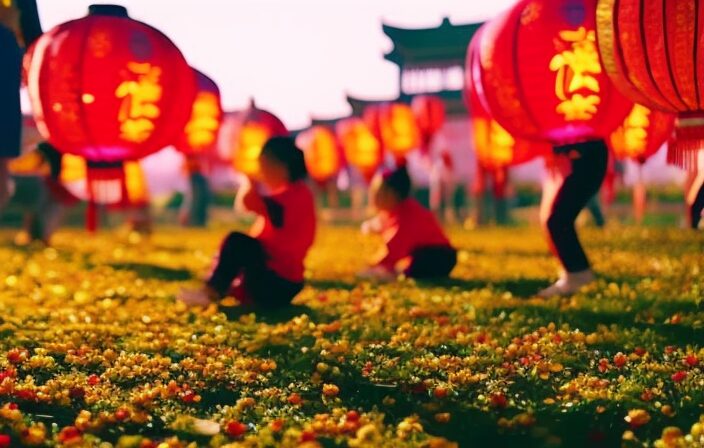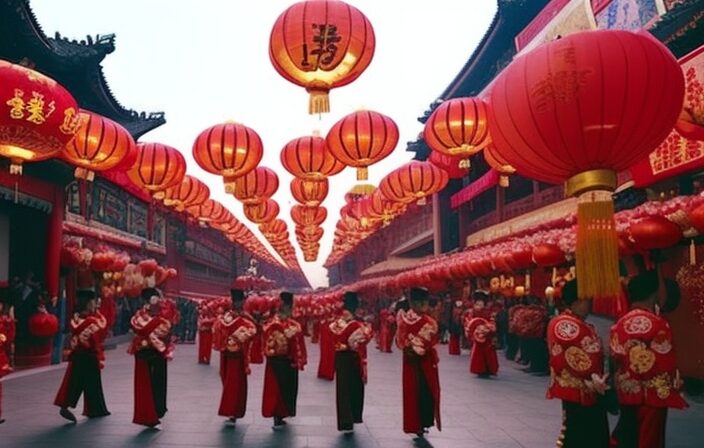Get ready to immerse yourself in the vibrant world of traditional Lunar New Year games and activities.
From the electrifying Lion Dance and Dragon Dance performances to the intellectually stimulating Lantern Riddles, this annual celebration is bursting with cultural richness and excitement.
Discover the thrill of the Red Envelope Game and the competitive spirit of Tug-of-War.
Engage in the timeless charm of traditional board games.
Join us as we delve into the captivating traditions that make Lunar New Year truly unforgettable.
Key Takeaways
- Lion Dance and Dragon Dance are integral components of Lunar New Year festivities, showcasing vibrant costumes, intricate choreography, and traditional symbolism.
- Lantern Riddles are popular intellectual activities during Lunar New Year celebrations, promoting logical thinking, creativity, and fostering a sense of community and camaraderie.
- The Red Envelope Tradition involves exchanging red envelopes filled with money, symbolizing good luck and blessings, and following certain etiquette when participating.
- Symbolic Games like Tug-of-War symbolize strength, unity, and friendly competition, played during Lunar New Year festivities to drive away evil spirits and bring good luck. Traditional board games like Chess, Mahjong, and Go offer a wide range of challenges and entertainment, enjoyed by generations and still widely played today.
Lion Dance and Dragon Dance
The Lion Dance and Dragon Dance are integral components of the Lunar New Year festivities, showcasing vibrant costumes, intricate choreography, and traditional symbolism. These traditional Chinese dances hold great cultural significance and are deeply rooted in Chinese folklore and mythology.
The Lion Dance is believed to bring good luck and ward off evil spirits. The lion symbolizes power, wisdom, and courage in Chinese culture. The dance involves two performers, one as the head and the other as the tail of the lion. They move in sync, mimicking the movements of a lion, while accompanied by the rhythmic beats of drums, cymbals, and gongs. The lion’s movements are acrobatic and graceful, requiring strength, agility, and precision.
On the other hand, the Dragon Dance symbolizes prosperity and good fortune. The dragon represents a divine creature in Chinese mythology and is believed to bring rain for a bountiful harvest. The dance involves a long dragon made of silk and bamboo, carried by a team of performers who manipulate its movements using poles. The dragon’s movements are dynamic and serpentine, requiring coordination, teamwork, and skill.
Both the Lion Dance and Dragon Dance require extensive training and technique. Performers spend years perfecting their skills, learning the intricate choreography, and mastering the art of embodying the spirit of the lion or dragon. These dances not only entertain the audience but also preserve and celebrate Chinese culture and traditions.
Lantern Riddles
Lantern riddles have long been an integral part of the festivities during this cultural celebration. Riddle solving is a popular activity during the Lunar New Year, and lantern riddles provide a fun and engaging way for people to test their wit and intelligence. These riddles are usually written on colorful lanterns and hung in public places, such as temples or parks, for everyone to enjoy.
The cultural significance of lantern riddles lies in their ability to promote intellectual and social interaction. Solving riddles requires logical thinking and creativity, and it encourages people to engage in friendly competitions, challenging themselves and others to find the correct answers. This tradition fosters a sense of community and camaraderie among participants.
Moreover, lantern riddles often carry auspicious meanings that are associated with the Lunar New Year. They may touch upon themes such as luck, prosperity, and good fortune. By solving these riddles, people not only exercise their mental agility but also immerse themselves in the festive atmosphere and embrace the traditional values and beliefs of the celebration.
Red Envelope Game
One popular game during the festivities involves exchanging red envelopes filled with money as a symbol of good luck and blessings. Red envelopes, also known as ‘hongbao’ in Mandarin, are traditionally given by married couples or elders to children and unmarried individuals. This game is not only a way to share blessings and well-wishes but also a way to celebrate the Lunar New Year in a joyful and prosperous manner.
When participating in the red envelope game, it is important to follow certain etiquette:
- Do not open the red envelope in front of the giver, as it can be seen as impolite.
- Express gratitude and appreciation when receiving a red envelope.
- Avoid giving back red envelopes to the same person who gave it to you, as it may be considered disrespectful.
To make the red envelope game more exciting and visually appealing, many people have started using creative designs for their red envelopes. Some popular creative red envelope designs include:
- Embroidered red envelopes with intricate patterns and designs.
- Red envelopes with personalized messages or greetings.
- Red envelopes adorned with traditional Chinese symbols like the dragon or the phoenix.
These creative designs not only enhance the beauty of the red envelopes but also add a personal touch to the exchange of blessings and good fortune.
Tug-of-War
Tug-of-War is a popular activity during Lunar New Year festivities, symbolizing strength, unity, and friendly competition. This traditional game has a rich history and cultural significance, making it a favorite among participants of all ages.
The origins of Tug-of-War can be traced back to ancient civilizations, with evidence of the game being played in ancient Egypt, Greece, and China. In Chinese culture, Tug-of-War is associated with the mythical Nian, a creature that was believed to terrorize villages during the New Year. The game was believed to drive away the Nian and bring good luck for the upcoming year.
While the basic rules of Tug-of-War remain the same, there are variations in how the game is played across different regions. In some areas, teams are divided based on gender or age, while in others, there are no restrictions. The game can be played on land or in water, with teams pulling on a rope or a pole. The objective is to pull the opposing team towards a designated point, with the team that successfully moves their opponents winning the game.
Tug-of-War is not only a fun activity but also a way to foster teamwork, unity, and resilience. It brings people together, fostering a sense of community and camaraderie. During Lunar New Year celebrations, Tug-of-War tournaments are organized, attracting participants and spectators alike.
Traditional Board Games
Chess, mahjong, and go are some of the timeless board games that have been enjoyed by generations and continue to be popular forms of entertainment in many cultures. These traditional board games have stood the test of time and are still widely played today.
In addition to these classics, there are also numerous variations of chess and other strategic games that have emerged over the years, adding new dimensions and challenges to the gameplay. Some of these variations include Fischer Random Chess, where the starting positions of the pieces are randomized, and Three-Check Chess, where the objective is to check the opponent’s king three times.
Aside from chess variations, dice games are also an integral part of traditional board game culture. These games often involve rolling dice and making strategic decisions based on the outcome. One popular example is Liar’s Dice, where players bluff and bid on the number of dice with a certain value. Another well-known dice game is Backgammon, which combines luck and strategy as players try to move their pieces around the board and bear them off before their opponent.
Whether it’s the intricate strategies of chess variations or the excitement of dice games, traditional board games offer a wide range of challenges and entertainment for players of all ages.
What is the Significance of Lunar New Year Decorations in Traditional Games and Activities?
Traditional lunar new year decorations and significance play a vital role in enhancing the ambiance and cultural essence of games and activities during the Lunar New Year celebration. Adorned with vibrant red colors and adorned with traditional symbols, these decorations symbolize luck, prosperity, and warding off evil spirits. By incorporating these decorative elements, traditional games and activities gain cultural authenticity and create a festive atmosphere that resonates with the spirit of Lunar New Year.
Conclusion
In conclusion, the traditional Lunar New Year games and activities bring joy and excitement to the festive celebration.
From the captivating Lion Dance and Dragon Dance to the brain-teasing Lantern Riddles, these rituals engage and entertain people of all ages.
The Red Envelope Game adds an element of luck and anticipation, while Tug-of-War promotes teamwork and strength.
Lastly, the Traditional Board Games offer a nostalgic and strategic experience.
These customs embody the rich cultural heritage of the Lunar New Year, making it a truly special occasion.



